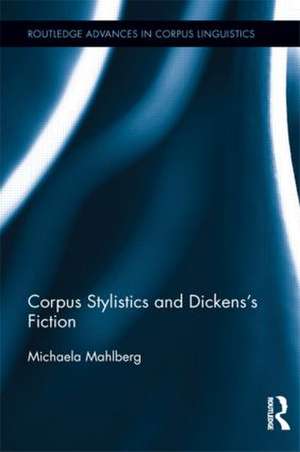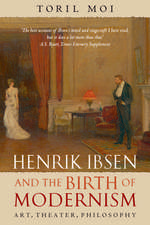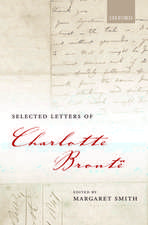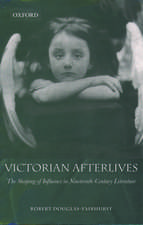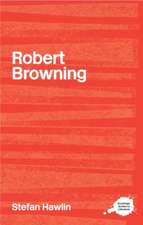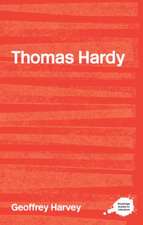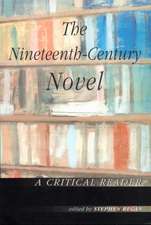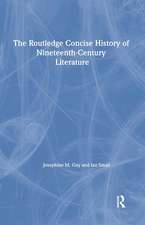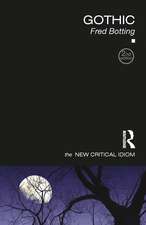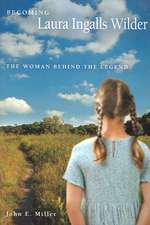Corpus Stylistics and Dickens's Fiction: Routledge Advances in Corpus Linguistics
Autor Michaela Mahlbergen Limba Engleză Paperback – 21 mai 2015
| Toate formatele și edițiile | Preț | Express |
|---|---|---|
| Paperback (1) | 430.80 lei 43-57 zile | |
| Taylor & Francis – 21 mai 2015 | 430.80 lei 43-57 zile | |
| Hardback (1) | 1059.84 lei 43-57 zile | |
| Taylor & Francis – noi 2012 | 1059.84 lei 43-57 zile |
Din seria Routledge Advances in Corpus Linguistics
-
 Preț: 472.23 lei
Preț: 472.23 lei -
 Preț: 464.54 lei
Preț: 464.54 lei -
 Preț: 436.14 lei
Preț: 436.14 lei -
 Preț: 187.52 lei
Preț: 187.52 lei - 26%
 Preț: 764.20 lei
Preț: 764.20 lei - 12%
 Preț: 298.83 lei
Preț: 298.83 lei -
 Preț: 414.70 lei
Preț: 414.70 lei -
 Preț: 390.57 lei
Preț: 390.57 lei - 18%
 Preț: 1013.21 lei
Preț: 1013.21 lei - 22%
 Preț: 325.00 lei
Preț: 325.00 lei - 16%
 Preț: 273.85 lei
Preț: 273.85 lei - 21%
 Preț: 257.25 lei
Preț: 257.25 lei -
 Preț: 326.03 lei
Preț: 326.03 lei -
 Preț: 387.38 lei
Preț: 387.38 lei -
 Preț: 481.58 lei
Preț: 481.58 lei -
 Preț: 416.22 lei
Preț: 416.22 lei -
 Preț: 416.22 lei
Preț: 416.22 lei -
 Preț: 482.56 lei
Preț: 482.56 lei -
 Preț: 389.66 lei
Preț: 389.66 lei -
 Preț: 483.55 lei
Preț: 483.55 lei - 13%
 Preț: 310.63 lei
Preț: 310.63 lei - 18%
 Preț: 999.51 lei
Preț: 999.51 lei - 18%
 Preț: 1000.27 lei
Preț: 1000.27 lei - 12%
 Preț: 299.25 lei
Preț: 299.25 lei - 12%
 Preț: 300.49 lei
Preț: 300.49 lei - 18%
 Preț: 1275.71 lei
Preț: 1275.71 lei -
 Preț: 467.44 lei
Preț: 467.44 lei -
 Preț: 384.66 lei
Preț: 384.66 lei
Preț: 430.80 lei
Nou
Puncte Express: 646
Preț estimativ în valută:
82.43€ • 86.29$ • 68.61£
82.43€ • 86.29$ • 68.61£
Carte tipărită la comandă
Livrare economică 31 martie-14 aprilie
Preluare comenzi: 021 569.72.76
Specificații
ISBN-13: 9781138900073
ISBN-10: 1138900079
Pagini: 240
Ilustrații: 48 black & white illustrations, 24 black & white tables, 7 black & white halftones, 4 black & white line drawings
Dimensiuni: 152 x 229 x 22 mm
Greutate: 0.33 kg
Ediția:1
Editura: Taylor & Francis
Colecția Routledge
Seria Routledge Advances in Corpus Linguistics
Locul publicării:Oxford, United Kingdom
ISBN-10: 1138900079
Pagini: 240
Ilustrații: 48 black & white illustrations, 24 black & white tables, 7 black & white halftones, 4 black & white line drawings
Dimensiuni: 152 x 229 x 22 mm
Greutate: 0.33 kg
Ediția:1
Editura: Taylor & Francis
Colecția Routledge
Seria Routledge Advances in Corpus Linguistics
Locul publicării:Oxford, United Kingdom
Public țintă
Postgraduate and UndergraduateCuprins
1. Corpus stylistics 2. Textual building blocks of fictional worlds 3. Starting with the texts: corpora, clusters and lexical bundles 4. Groups of clusters for the identification of local textual functions 5. Character speech 6. Body language 7. As if and the narrator comment 8. Labels – contextualising and highlighting functions 9. Conclusions and outlook
Notă biografică
Michaela Mahlberg is Professor of English Language and Linguistics at the University of Nottingham, UK.
Recenzii
“Michaela Mahlberg’s work on Dickens is ground-breaking and genuinely important because it analyses and brings into dialogue major aspects of his writing that have been wrongly and strangely neglected in modern criticism: in particular, his language and characterisation. The neglect of these fundamental characteristics of Dickens’s fiction may have resulted from disciplinary fissures, the divergence of ‘Language’ from ‘Literature’, History from Aesthetics. Here too, Mahlberg proves herself a pioneer, not only integrating the methods of English Language – in particular, Corpus Linguistics - with English Literature, but in so doing, applying technology creatively to textual analysis. Corpus Stylistics and Dickens’s Fiction opens up a whole new vista on Dickens’s work, suggesting fertile and productive angles for future research.”
– Juliet John, Royal Holloway, University of London, UK
“Mahlberg offers us a first-rate study of Dickens's fiction, carried out at the intersection of four major domains of research: corpus-linguistic research methods, the study of phraseology, text linguistics, and literary stylistics. By applying corpus-driven analytical methods, Mahlberg helps us understand some of the major phraseological devices that Dickens employs to create the memorable characters that we all love. This book will be of interest for both its theoretical contributions in the areas of corpus linguistics and literary stylistics, as well as for its detailed descriptions of Dickens's style.”
– Douglas Biber, Northern Arizona University, USA
“Michaela Mahlberg’s book provides both a structured introduction to the field of corpus stylistics, which has become increasingly popular over the past few years, and corpus-stylistic case studies focusing on Charles Dickens’s work. Mahlberg shows that the combination of corpus-linguistic methods and literary-stylistic approaches opens up entirely new perspectives on the description and analysis of how literary texts ‘work’. This book shows in a refreshingly innovative way how the great divide between literary preoccupation with the creative potential of individual authors and texts on the one hand and the corpus-linguistic identification of general routines in language use on the other can be overcome – this book is a must for everyone who intends to join the ever-growing corpus-stylistic community.”
– Joybrato Mukherjee, University of Giessen, Germany
“I’ve been eagerly awaiting the publication of this innovative book for some months now. Michaela Mahlberg’s work is both highly creative and rigorous methodologically. I think it is a must-read book for anyone interested in corpus stylistics, stylistics more generally, corpus linguistics and Dickens studies. Mahlberg reveals fascinating patterns of ‘phrasal’ repetition scattered through Dickens’s novels which influence readers, mainly subliminally, when they read his work.”
– Mick Short, Lancaster University, UK
"It is clearly and engagingly written and has insights to offer those who want to use computers to analyse texts." - Marianne, Berlin International School, Germany
"...the book will remain an important landmark in the branch of corpus approaches to literature which explore repeated sequences in texts. The interdisciplinary fabric woven around clusters and characterization is very impressive in its erudition and clarity and highlights connections between authors as different ad Biber, Gavins and Rosenberg." - Marija Milokovic, University of Belgrade, English Text Construction
– Juliet John, Royal Holloway, University of London, UK
“Mahlberg offers us a first-rate study of Dickens's fiction, carried out at the intersection of four major domains of research: corpus-linguistic research methods, the study of phraseology, text linguistics, and literary stylistics. By applying corpus-driven analytical methods, Mahlberg helps us understand some of the major phraseological devices that Dickens employs to create the memorable characters that we all love. This book will be of interest for both its theoretical contributions in the areas of corpus linguistics and literary stylistics, as well as for its detailed descriptions of Dickens's style.”
– Douglas Biber, Northern Arizona University, USA
“Michaela Mahlberg’s book provides both a structured introduction to the field of corpus stylistics, which has become increasingly popular over the past few years, and corpus-stylistic case studies focusing on Charles Dickens’s work. Mahlberg shows that the combination of corpus-linguistic methods and literary-stylistic approaches opens up entirely new perspectives on the description and analysis of how literary texts ‘work’. This book shows in a refreshingly innovative way how the great divide between literary preoccupation with the creative potential of individual authors and texts on the one hand and the corpus-linguistic identification of general routines in language use on the other can be overcome – this book is a must for everyone who intends to join the ever-growing corpus-stylistic community.”
– Joybrato Mukherjee, University of Giessen, Germany
“I’ve been eagerly awaiting the publication of this innovative book for some months now. Michaela Mahlberg’s work is both highly creative and rigorous methodologically. I think it is a must-read book for anyone interested in corpus stylistics, stylistics more generally, corpus linguistics and Dickens studies. Mahlberg reveals fascinating patterns of ‘phrasal’ repetition scattered through Dickens’s novels which influence readers, mainly subliminally, when they read his work.”
– Mick Short, Lancaster University, UK
"It is clearly and engagingly written and has insights to offer those who want to use computers to analyse texts." - Marianne, Berlin International School, Germany
"...the book will remain an important landmark in the branch of corpus approaches to literature which explore repeated sequences in texts. The interdisciplinary fabric woven around clusters and characterization is very impressive in its erudition and clarity and highlights connections between authors as different ad Biber, Gavins and Rosenberg." - Marija Milokovic, University of Belgrade, English Text Construction
Descriere
This book presents a way into the Dickensian world that starts from linguistic patterns, employing corpus linguistic methodology to study electronic versions of his texts. With its corpus stylistics focus, the book presents an innovative approach to the language of one of the most popular English authors, taking a fresh view on aspects such as characterization, speech and body language. Thus, Mahlberg bridges the gap between linguistic and literary studies, providing a useful resource for both researchers and students of language and literature.
